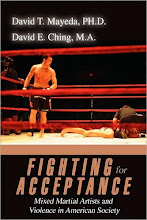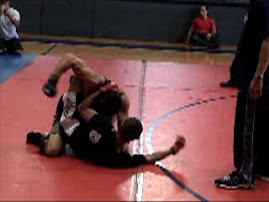 Another public shooting by an unstable male, this time at the LA Fitness sporting club in Bridgeville, Pennsylvania. The 48-year-old male perpetrator, George Sodini, reportedly entered the gym, went into an aerobics room with female attendees, turned out the lights and opened fire on the complete strangers. Twelve women were shot, three fatally. Sodini then committed suicide by shooting himself.
Another public shooting by an unstable male, this time at the LA Fitness sporting club in Bridgeville, Pennsylvania. The 48-year-old male perpetrator, George Sodini, reportedly entered the gym, went into an aerobics room with female attendees, turned out the lights and opened fire on the complete strangers. Twelve women were shot, three fatally. Sodini then committed suicide by shooting himself.Emerging reports about Sodini’s online blog are providing further insight into the motives behind his actions, specifically identifying insecurities he held about his sexual masculinity. From the New York Times:
Tortured by loneliness and his lack of success with women, George Sodini developed a plan to get even. On Tuesday night, he executed it, opening fire in a fitness center here and hitting 12 women, 3 fatally, before turning a gun on himself.
Mr. Sodini, 48, described his anger and frustration in painstaking detail in notes he carried with him and left at his home and in a chilling online diary, offering an extraordinarily stark portrait of a killer’s motives. Officials said Mr. Sodini, of Scott Township, a suburb about six miles southwest of Pittsburgh, prepared for the assault for at least nine months, buying ammunition and at least three guns and making practice runs to the fitness center.
[…]
In his online journal, which has since been taken off the Internet, Mr. Sodini, a programmer-analyst at a local law firm, said that he had not had a girlfriend since 1984 and that he had not had sex since July 1990, when he was 29.
"I actually look good," Mr. Sodini wrote in an entry dated Dec. 29, 2008. "I dress good, am clean-shaven, bathe, touch of cologne — yet 30 million women rejected me — over an 18- or 25-year period. That is how I see it. Thirty million is my rough guesstimate of how many desirable single women there are.
"A man needs a woman for confidence. He gets a boost on the job, career, with other men, and everywhere else when he knows inside he has someone to spend the night with and who is also a friend."
Note his isolation (i.e., anomie). But more importantly, I recently read an absolutely outstanding journal article by Angela Harris titled "Gender, Violence, Race, and Criminal Justice," published in the Stanford Law Review. Among making a number of excellent points in the article, Harris theorizes masculinity, its relationships to gendered insecurity and violence:
Manliness is one of those ideas that is often made real with violence. Violent acts often carry idiosyncratic moral or emotional meanings to the perpetrator. But violent acts are also, sometimes, the result of the character of masculinity itself as a cultural ideal. In these cases, men use violence or the threat of violence as an affirmative way of proving individual or collective masculinity, or in desperation when they perceive their masculine selfidentity to be under attack. (p. 781).
Later, Harris discusses work by Jackson Katz and James Gilligan in her footnotes, offering further perspective into the Pennsylvania tragedy, specifically describing issues of male sexual anxiety, additional patriarchal gender-role expectations, and the potential for violence:
"Humiliation always embodies an awareness of impotence," remarks Katz. Conversely, impotence-literal or figurative-always brings with it the threat of humiliation. Katz's analysis connects humiliation to male gender identity since women cannot be impotent.
Gilligan, based on interviews with violent criminals, argues that the main motives for violence are "the fear of shame and ridicule, and the overbearing need to prevent others from laughing at oneself by making them weep instead." GILLIGAN, supra note 14, at 77 (1996). Gilligan also connects this emotional dynamic explicitly with gender:
The male gender role generates violence by exposing men to shame if they are not violent, and rewarding them with honor when they are. The female gender role also stimulates male violence at the same time that it inhibits female violence. It does this by restricting women to the role of highly unfree sex objects, and honoring them to the degree that they submit to those roles or shaming them when they rebel. This encourages men to treat women as sex objects, and encourages women to conform to that sex role; but it also encourages women (and men) to treat men as violence objects. It also encourages a man to become violent if the woman to whom he is related or married "dishonors" him by acting in ways that transgress her prescribed sexual role. (p. 789, 790).
Harris’s article is a highly recommended read, as she also delves into the public's romance with gender violence and the hyper-masculine composition of predominantly male groups (namely police departments, street gangs, and the state). Our fascination with gender violence coupled with violent male institutions results in the public believing that "a certain amount of gender violence is necessary for law and order" (p. 802).
More from Harris on the social construction of gender:
Most of what is important about masculinity and femininity is not innate, but rather is generated by social institutions and conventions. If masculine gender performances repeatedly take certain destructive forms, this is not because men are inherently bad but because social conventions take on a life of their own. The question is not how to alter men's nature, then, but what can be done to alter the connections between masculinity and violence. (p. 802).
Thus, in order to prevent and reduce shootings like that carried out by Sodini, Harris theorizes that institutions need to be de-gendered. The specific examples she uses are police departments. Theoretically, however, her analysis would also call to revamp the media and other institutions that influence men like Sodini to feel inadequate and to feel that adequacy can be achieved by dominating women through various forms of abuse (sexual, economic, emotional, physical...in this case death). To say the least, extensive gendered reform is needed.
Full citation for the Harris article:
Harris, Angela P. (2000). Gender, violence, race, and criminal justice. Stanford Law Review, 52 (4), 777-807.
More multimedia on the tragedy from a Reuters post.









this is the only time I'll ever visit your blog, but wanted to exercise my rights here. The more society wanders from religion, the more sociology is skewed. Degendering is a bad idea in my opinion. Instead, why don't we celebrate our differences? If Sodini were a Christian man, he could have gone to a church and found a nice woman in a month or less...(one in 30,000,000?) A good Christian woman doesn't put alot of stock into a man that "dresses well, is clean shaven, or has a splash of cologne...." Her main concern is whether or not he is a Godly man, a man that will love her unconditionally.
ReplyDelete"The male gender role generates violence by exposing men to shame if they are not violent, and rewarding them with honor when they are."
I couldn't disagree with this statement more, you are using this in a context of war and discounting the reward for bravery and selflessness...as a Christian man, I am rewarded by the love of my family and students that I teach by showing them respect, love, and care...NOT violence. Why do I put my son in time out when he hits others? I continue to reward him for being polite and showing sacrifice. Please continue to be fair and balanced by looking at the Christian male and female perspective. I realize that's tough to do given the state of our society...but at least try.
No such thing as a violent Christian? Pull the other one, it's got fucking bells on
DeleteI'm commenting on a three-year-old post and there's nothing you can do to stop me. Anyway, I doubt Sodini ever took a long enough look in the mirror to see the insecure little boy beneath the grooming. For that matter, I doubt he ever got to know a woman well enough to see her as more than a dopamine release.
ReplyDelete